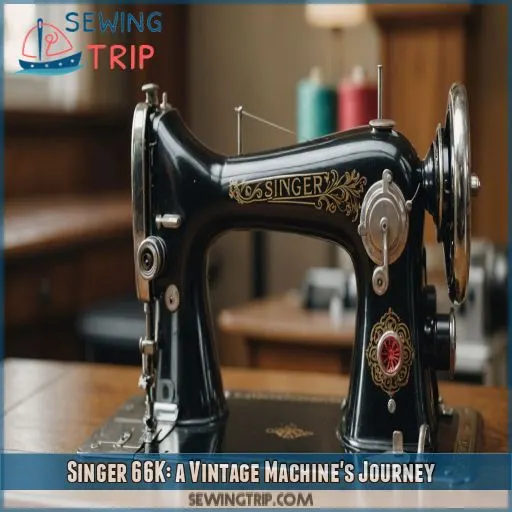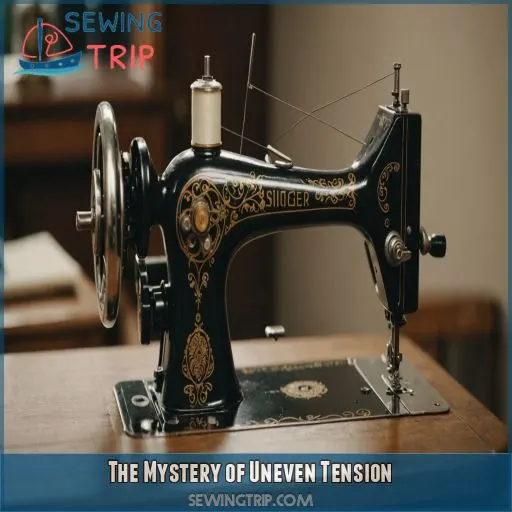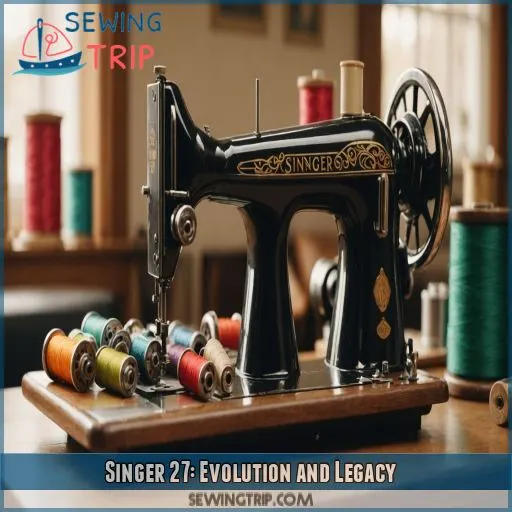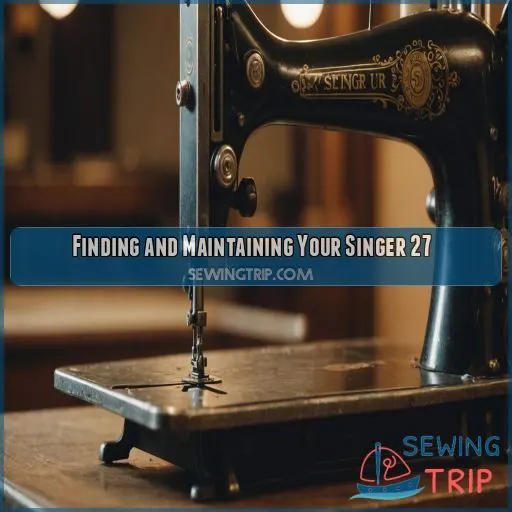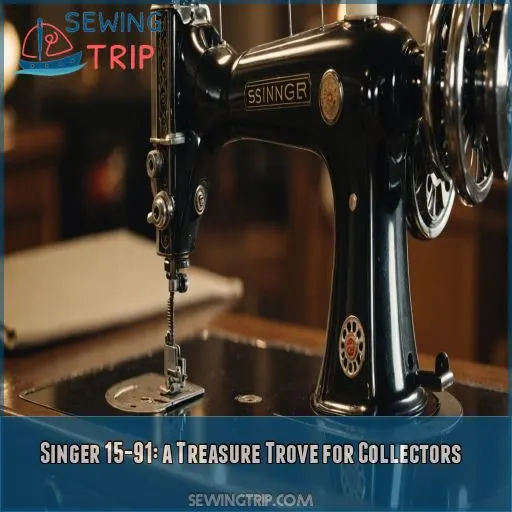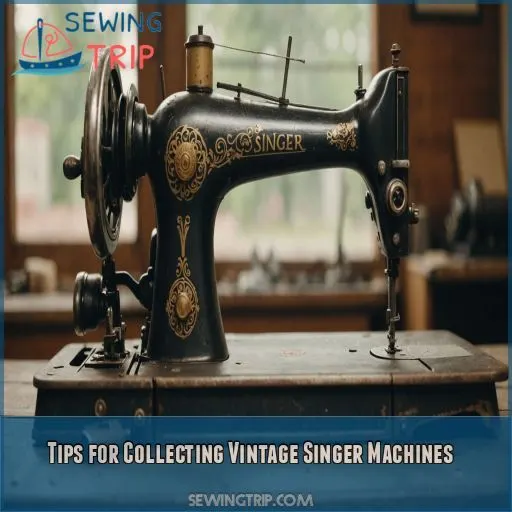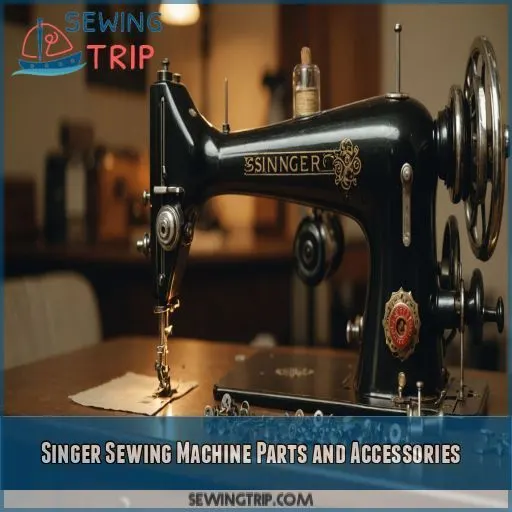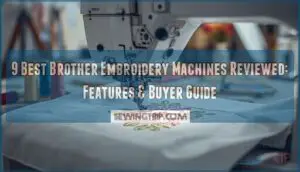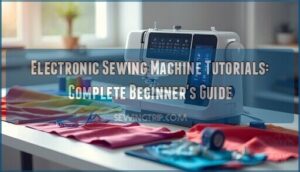This site is supported by our readers. We may earn a commission, at no cost to you, if you purchase through links.
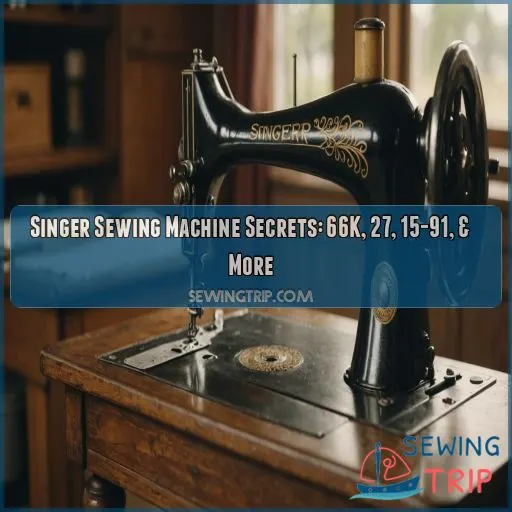
If you’re specifically looking for a Singer sewing machine with a circular feed wheel, the Singer Circular Stitcher for Touch & Sew Sewing Machine could be what you’re after. This model comes in its original box and is available on Amazon.
To learn more about the Singer Corporation and its long history of sewing machine innovation, keep reading.
Table Of Contents
- Key Takeaways
- Singer 66K: a Vintage Machine’s Journey
- The Mystery of Uneven Tension
- Singer 27: Evolution and Legacy
- Finding and Maintaining Your Singer 27
- Singer 15-91: a Treasure Trove for Collectors
- Tips for Collecting Vintage Singer Machines
- Singer Sewing Machine Parts and Accessories
- Frequently Asked Questions (FAQs)
- Conclusion
Key Takeaways
- Singer’s vintage sewing machines, like the 66K and 27, are sought after for their craftsmanship, unique features, and a glimpse into the evolution of sewing technology.
- The mystery of uneven thread tension can be traced back to a sneaky gunk blob causing jolts in the upper thread. Keep sewing to dissolve the gunk and stabilize your stitching.
- Collecting vintage Singer machines? Familiarize yourself with serial numbers, date codes, model variations, and join the sewing machine community to spot fakes and restore with confidence.
- From leather belts to back-clamping feet, exploring replacement and upgrade options for your Singer sewing machine can enhance performance and extend its life.
Singer 66K: a Vintage Machine’s Journey
Singer 66K, a vintage sewing machine manufactured in 1907, takes us on a journey through time. From its unique features and restoration process to its sewing capabilities, this machine has a story to tell and secrets to reveal.
Unique Features and History
The Singer 66K, a vintage sewing machine, has an intriguing history.
It was manufactured in Scotland in 1907 and was part of the first batch of its kind.
This heavy-duty machine boasts unique features, like a low-mounted bobbin winder and a 12-spoked balance wheel.
Its decals are also distinctive, with filled centers on the bed and red-tipped flowers.
This machine is a great example of the craftsmanship of vintage machines and offers a glimpse into the evolution of sewing technology.
Restoration Process
Restoration is a labor of love, and your Singer 66K is worth the effort.
You’ll want to begin with a thorough cleaning, using soapy water to remove grime, grease, and degraded shellac.
Next, you’ll tackle rust removal from the balance wheel, ensuring it’s good as new.
The fun part? Applying new decals to the arm and column, giving your machine a fresh look.
Finally, a coat of polyurethane varnish adds shine and protection.
It’s a journey back in time, with a touch of creativity and elbow grease.
Sewing Performance and Capabilities
The Singer 66K is a heavy-duty machine with a strong feed and punching power, perfect for thicker fabrics. It’s not ideal for delicate fabrics like chiffon due to its tight seams. Here are some tips for getting the most out of this vintage machine:
- Fabric types: While the 66K excels with thicker fabrics, it can also handle delicate fabrics with a few adjustments.
- Feed dogs: You can set the feed dogs lower than on other machines for a gentler touch with delicate fabrics.
- Needle selection: Experiment with different needle sizes and types to find the best match for your fabric.
- Foot pressure: Adjusting the foot pressure can help you navigate uneven thicknesses and prevent the machine from getting stuck.
- Thread tension: Keep an eye on thread tension, as external factors like speeding up or slowing down can affect your stitch quality.
The Mystery of Uneven Tension
Have you ever noticed your thread tension acting up, with the blue top thread poking through when it shouldn’t? It’s a mystery why this happens, and it can be frustrating to fix. Let’s unravel this enigma together and get your sewing machine running smoothly again.
Identifying the Culprit
So, what’s the deal with uneven tension? Imagine sewing along, only to have your blue top thread poking through where it shouldn’t. You might blame your speed, the spool, or even yourself, but there’s a sneaky culprit hiding in the lower mechanism—a gunk blob. This gunk causes jolts in the upper thread, leading to those pesky tension issues.
Resolving the Issue
Now that you’ve identified the gunk blob as the culprit, it’s time to fix the uneven tension. Here are some practical steps to take:
- Don’t panic: It’s important to remain calm and remember that this issue can be fixed.
- Keep sewing: Instead of stopping, continue to sew. The movement will help dissolve the gunk and eliminate the jolts affecting your thread tension.
- Install a pre-tensioner: As a long-term solution, consider installing a pre-tensioner to mitigate the effects of jolts on the thread tension. This will help stabilize your stitching.
- Clean and maintain: Regularly clean and maintain your machine to prevent gunk build-up and make sure your sewing goes smoothly.
Singer 27: Evolution and Legacy
Let’s take a closer look at the evolution of the Singer 27, a sewing machine that debuted in the late 19th century and left a lasting impact. From its vibrating shuttle debut to its enduring popularity, we’ll explore what made this machine a staple in homes for decades.
The Vibrating Shuttle’s Debut
Back in 1885, Singer introduced the VS-1, the first of its kind. The VS-1, short for Vibrating Shuttle 1, was designed as a more affordable option compared to the older TS machine. The VS-1’s unique selling point? A vibrating shuttle that created a lockstitch by moving in an arch from the rear to the front of the machine. Talk about innovation!
The VS-1 was built with simplicity in mind, making it reliable and easy to service and maintain. This was a machine aimed at residential users, and its cost-effectiveness and reliability quickly made it a hit with the average consumer. The VS-1’s success set the stage for the Singer 27 family of sewing machines, which would go on to become a household name.
Model Revisions and Improvements
The Singer 27 family of sewing machines went through several model revisions, leading to improvements and enhancements over time. These revisions were key to the evolution of the Singer 27, building on the foundation laid by the debut of the vibrating shuttle.
The original VS-1, introduced in 1885, was soon followed by the VS in 1886, marking the first revision. This was a full-size model, weighing in at 27.7 pounds, making it a sturdy and stable option for treadle operation. The VS was designed with simplicity in mind, both in terms of how it was made and how it was serviced, which contributed to its reliability and cost-effectiveness.
Not ones to rest on their laurels, Singer quickly released the VS, a 3/4 size model that was lighter and more portable. This revision showed Singer’s commitment to innovation and responsiveness to diverse consumer needs.
In 1891, Singer took things a step further, revising the VS and VS again and reintroducing them as the Model 27 (full size) and Model 28 (3/4 size). These models represented the culmination of years of refinement and improvement, solidifying Singer’s reputation for quality and performance.
Enduring Quality and Popularity
The Singer 27 family has an impressive legacy, with some models in production until 1960. That’s a seriously long run, proving their enduring popularity. These machines are known for their durability, reliability, and versatility, with a dedicated following of collectors and enthusiasts. Many Singer 27s are still in working condition, showing their quality.
Finding and Maintaining Your Singer 27
You want a Singer 27, but where do you even start? Finding one of these vintage machines can be like hunting for treasure. Once you’ve tracked down your Singer 27, you’ll want to keep it in tip-top shape with proper maintenance and care.
Unlocking the Machine’s History
Finding your Singer 27 serial number is like discovering a secret key that reveals its history. That serial number is typically located on the right side of the machine head, near the needle clamp. With it, you can uncover manufacturing dates, model variations, and other rare features. It’s like a treasure map leading you through the machine’s journey and unique story.
Regular Maintenance and Care
Keeping your Singer 27 in good condition involves regular cleaning, lubrication, and troubleshooting.
Give it some TLC and it’ll keep sewing smoothly.
Clean and oil it regularly to keep things running smoothly.
Sewing machine oil is your friend here.
You can find it online or at craft stores.
Don’t forget to wipe down the exterior with a soft cloth to keep it looking sharp.
Replacing Worn Parts and Accessories
If your Singer 27 is acting up, it might be time to replace some worn parts and accessories. Here’s a guide to help you get your machine running like new again:
- Identify the problem: Is your machine making strange noises? Are stitches uneven or skipping? By pinpointing the issue, you can narrow down the culprit part.
- Source replacement parts: Common replacement parts include belts, shuttles, bobbins, check springs, slide plates, needle plates, bobbin tires, and tension components. Many online retailers specialize in providing these parts.
- DIY or Pro?: Consider your comfort level and skills. While some repairs are simple, others may require a professional.
- Install and test: With new parts installed, test your machine on a scrap fabric. Adjust settings as needed for smooth stitching.
Singer 15-91: a Treasure Trove for Collectors
Whether you’re a seasoned collector or just starting out, the Singer 15-91 sewing machine is a gem worth seeking. With its unique features and rich history, it’s a treasure trove for anyone fascinated by vintage sewing machines.
Finding Your Perfect Match
Finding your dream Singer 15-91 is like hunting for buried treasure.
Set your budget, but remember, many sellers are open to a "best offer," so don’t be afraid to negotiate.
Beyond price, consider the machine’s condition, rarity, and age.
Older machines with unique features, like the Singer 66K, are rarer and may cost more.
Don’t forget to factor in shipping costs, which vary by seller and location.
Popular Items and Categories
If you’re looking for popular items, the Singer 15-91 sewing machine is a standout.
You’ll find a treasure trove of vintage sewing machines, each with its own unique charm.
But it’s not just about the machines. Sewing baskets and boxes offer stylish storage, while antique buttons add a touch of flair to your projects.
Foot pedals let you experience the classic way of operating these machines.
And if you’re curious about the history and inner workings, manuals and books are a must-have.
Pricing and Shipping Considerations
When hunting for your dream Singer 15-91, pricing and shipping costs can make or break the deal. Prices vary, so research similar listings to get a ballpark figure. Shipping costs are often included, but check with the seller, especially for heavy-duty machines. Auction trends and seller reputation also impact the final price, so be a smart cookie and shop around.
Tips for Collecting Vintage Singer Machines
So, you’re keen on collecting vintage Singer machines? It’s a fun and rewarding hobby, but there are a few things you should know. First, you need to do your research to spot a genuine Singer.
Research and Authenticity
When collecting vintage Singer machines, research and authenticity are key. You don’t wanna end up with a dud, right? So, how do you separate the wheat from the chaff?
First, get familiar with serial numbers and date codes. They’re like fingerprints, unique to each machine and can help you identify the model and manufacturing details. This info is really important for insurance purposes, too.
Next, watch out for model variations. Singer machines had different iterations, so know the subtle differences to avoid getting duped.
Lastly, join the sewing machine community. It’s a wealth of knowledge with enthusiasts who can help you spot fakes and share restoration ethics. Forums, blogs, and websites are your friends here.
Now you’ve got the tools to collect vintage Singer machines with confidence!
Condition and Value
When collecting vintage Singer machines, condition and value are key considerations. Here are some tips to help you navigate the process:
- Restoration Costs: Before purchasing a machine in need of restoration, consider the costs involved. Factor in the price of replacement parts, your time, and any professional services required.
- rarity Impact: Rare models in good condition can command higher prices. Research the model’s rarity and its impact on value.
- Age Factors: Older machines may have more wear and tear, impacting their functionality and value. Assess the machine’s age and how it affects its performance and desirability.
- Market Trends: Stay updated with market trends and demand for specific models. This can influence the machine’s value and your ability to resell it in the future.
- Seller Reputation: When buying from online retailers or individuals, research the seller’s reputation. This can give you insights into the machine’s authenticity, condition, and potential hidden issues.
Join groups like the sewing machine maintenance group to learn more about keeping your machine in good condition.
Enjoying the Process and Community
Collecting vintage Singer sewing machines is more than just a hobby—it’s a journey through time, connecting you to a passionate community of enthusiasts. Here are some tips to help you enjoy the process and tap into the vibrant Singer sewing machine community:
- Join community events: Keep an eye out for antique shows, flea markets, and sewing machine enthusiast gatherings. These events offer a treasure trove of unique finds and like-minded people to connect with.
- Restore and share: Restoring vintage machines is a labour of love. Share your restoration projects, before-and-after photos, and tips with the community. Online forums and social media groups are great platforms to showcase your work and exchange knowledge.
- Connect with other collectors: Engage with fellow collectors through sewing machine community groups, online forums, and social media platforms. Share stories, seek advice, and expand your network.
- Attend shows and events: Don’t miss in-person events like antique shows and flea markets. Hunt for hidden gems and connect with fellow collectors.
- Continue learning: Stay curious about vintage Singer machines. Follow online forums, newsletters, and expert advice to expand your knowledge.
Singer Sewing Machine Parts and Accessories
Whether you’re restoring a vintage Singer 66K or maintaining your trusty Singer 27, finding the right parts and accessories is key. From leather belts to replacement shuttles, we’ll guide you through the essentials to keep your Singer sewing machine running smoothly.
Leather Belts and Other Essentials
Leather belts are essential for keeping your vintage Singer sewing machine running smoothly. They connect the motor to the machine’s inner workings, transferring power to the shuttle carrier, thread guide, and slide plate. When replacing belts, make sure you select the correct type and size for your machine model. Proper belt care is important; avoid over-tightening, and consider belt alternatives if needed. Remember, a well-maintained leather belt helps your Singer keep stitching with ease.
Besides leather belts, other essential tools and parts include the shuttle carrier, thread guide, slide plate, and tension thumb nut. These components work together to guide the thread, control tension, and ensure smooth stitching. Regular maintenance and timely replacement of these parts are key to your Singer’s performance.
Replacing and Upgrading Parts
Let’s talk about taking control of your sewing destiny by replacing and upgrading parts on your Singer sewing machine. Whether you’re looking to restore an antique gem or supercharge your current setup, we’ve got you covered.
One of the perks of Singer sewing machines is the abundance of replacement parts available. You can easily find belts, shuttles, bobbins, and more from online retailers specializing in vintage sewing machines. It’s like a treasure hunt for the perfect fit!
Upgrading parts can offer enhanced performance and extended machine life. For example, you might opt for a back-clamping foot or a side-clamping foot, each offering unique benefits for specific sewing tasks. Waterslide decals can also give your machine a fresh, personalized look.
When it comes to parts, you’ve got options. Original Equipment Manufacturer (OEM) parts are made by Singer, ensuring a perfect fit and performance. Aftermarket parts, on the other hand, offer alternatives that might be more affordable or provide features that OEM parts don’t. It’s all about finding what works best for you and your machine.
Frequently Asked Questions (FAQs)
What is the difference between a Singer 27 and 28?
The Singer 27 is a full-size machine, while the 28 is a 3/4 size version. The 27 weighs 7 pounds, making it suitable for treadle operation. The 28 is lighter, making it ideal for portable use.
What year was the Singer 66 made?
The Singer 66 first hit the market in 1902. In 1907, the first all-British model was released. Some sources suggest it was made until the 1920s or even
How much is a Singer 15 88 worth?
The Singer 15-88 is a sought-after model, with prices varying based on condition, rarity, and age. For example, a user manual for the 15-88 is priced at $27 on Etsy.
What is my old Singer sewing machine worth?
It depends on the model, its rarity, and its condition. Most sell for $50 to $500, but some rare models go for over $2, Older machines in good working order are worth $100 or more.
How do I find my Singer 27s serial number?
You’re trying to figure out your Singer 27’s past, but a missing serial number has you stuck.
It’s like trying to piece together a puzzle with a missing corner piece.
The serial number is usually on the machine head‘s right side, near the needle clamp.
It might be stamped or engraved.
A silver plate often hosts the serial number in vintage models, so keep an eye out for that, too.
What parts need regular replacement?
Common replacement parts for the Singer 27 include belts, shuttles, bobbins, check springs, slide plates, needle plates, bobbin tires, and tension components.
Whats the best way to clean my machine?
Water and gentleness is key. Use a cotton cloth with soapy water to wash your machine. Rinse with clean water, then dry. Sewing machine oil can be used to polish the metal parts.
Where can I find vintage sewing machine parts?
You can find vintage sewing machine parts on websites like The Old Singer Shop, Discount Sewing Machine Parts, and Amazon. Etsy and eBay are also good options.
Whats the difference between a Singer 66K and a Singer 27?
The Singer 66 was the queen of its time, offering more foot clearance and space for professional sewers. The Singer 27 was a more affordable option. The 66K’s bed is longer, while the 99K’s is shorter.
Conclusion
Whether you’re a sewing enthusiast or a collector, Singer’s sewing machines offer a unique blend of history, performance, and innovation.
We’ve explored the secrets of the Singer 66K, 27, and 15-91, delving into their journeys, unique features, and maintenance tips. Along the way, we’ve also uncovered the mystery of uneven tension and shared insights on collecting vintage Singer machines.
If you’re on the hunt for a Singer sewing machine with a circular feed wheel, the Singer Circular Stitcher for Touch & Sew Sewing Machine could be your next treasure. So, keep an eye out for this model and continue exploring the fascinating world of Singer sewing machines.

